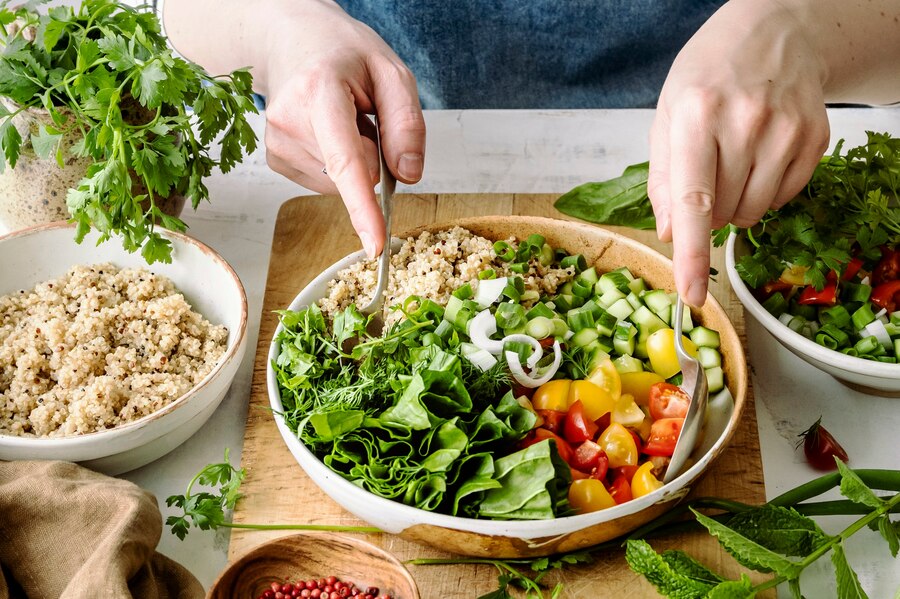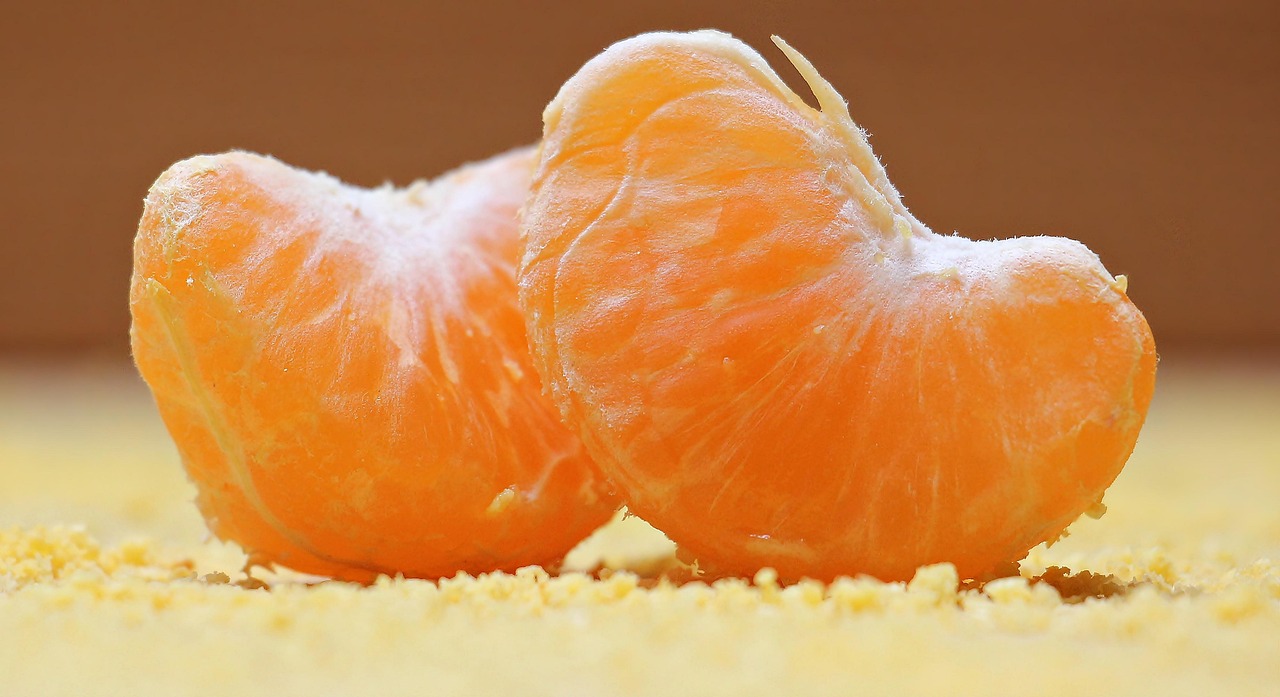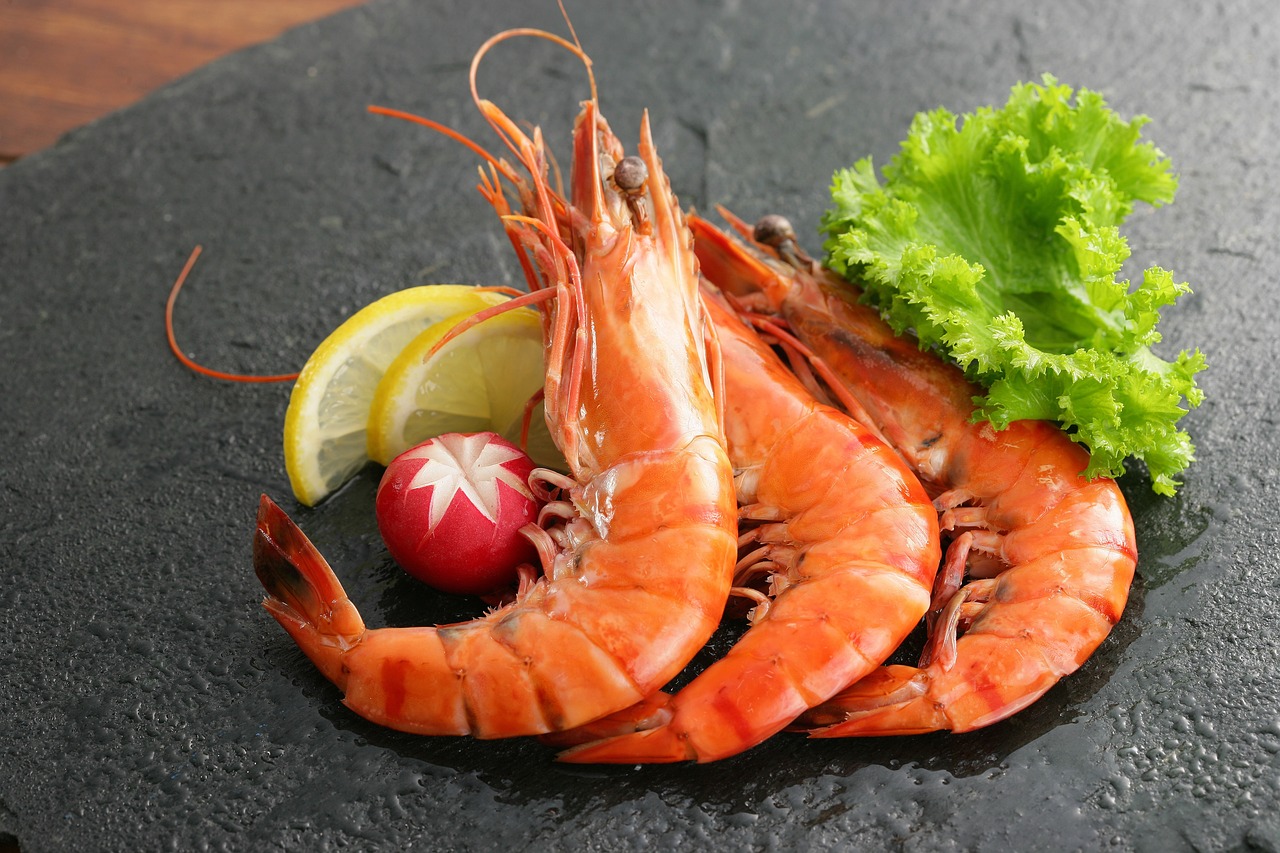Food And Drinks
Easy Vegetarian Meal Prep: Simple Tips for Healthy Eating

In today’s fast-paced world, maintaining a healthy lifestyle can often feel like a challenge. For vegetarians, meal prepping provides a sustainable and efficient solution to ensure nutritious meals are readily available throughout the week. This article will explore easy vegetarian meal prep ideas, tips for efficient preparation, and how meal prepping can help save time and reduce food waste. We will also discuss the latest trends and advice to keep your meal prep both delicious and nutritious.
Why Easy Vegetarian Meal Prep is a Game-Changer
Vegetarian meal prep offers numerous benefits beyond just saving time. Whether you’re trying to maintain a balanced diet, manage weight, or simply eat more vegetables, meal prepping makes achieving these goals much easier. Here’s why easy vegetarian meal prep is essential:
- Time-Saving: With busy schedules, cooking every meal from scratch can be overwhelming. Meal prepping ensures you have ready-to-eat meals without spending hours in the kitchen every day.
- Healthier Choices: Meal prepping allows you to control ingredients, reducing the reliance on processed foods and offering a healthier, plant-based diet.
- Budget-Friendly: By preparing meals in bulk, you can save money by reducing food waste and purchasing ingredients in larger quantities.
- Consistency: It’s easier to stick to a vegetarian diet when meals are prepared in advance. You won’t be tempted to skip meals or reach for unhealthy alternatives.
- Variety: Meal prepping doesn’t mean eating the same thing every day. By planning your meals, you can mix up your protein sources, grains, and vegetables to keep your diet exciting and flavorful.
Tips for Easy Vegetarian Meal Prep
To make meal prepping for a vegetarian diet easy and stress-free, follow these key tips:
1. Plan Your Meals Ahead of Time
The first step in successful meal prep is planning. Start by choosing a week’s worth of meals and snacks that align with your dietary goals. Consider a mix of breakfast, lunch, dinner, and snacks. A well-rounded meal prep plan should include:
- Protein Sources: Tofu, tempeh, chickpeas, lentils, beans, edamame, and quinoa.
- Grains: Brown rice, quinoa, farro, couscous, and bulgur.
- Vegetables: Leafy greens, carrots, sweet potatoes, bell peppers, and cauliflower.
- Healthy Fats: Avocados, nuts, seeds, olive oil, and nut butter.
- Seasonings & Sauces: Spices, herbs, tahini, soy sauce, and vinaigrette.
2. Batch Cook and Store
Cooking in bulk can save a significant amount of time. Consider preparing large batches of grains, beans, and roasted vegetables that can be used in multiple dishes. For instance, quinoa can be made in bulk and stored for use in salads, wraps, and grain bowls throughout the week.
Invest in good-quality containers that are microwave- and freezer-safe. Glass containers with tight-fitting lids work best, as they preserve the freshness of your meals and reduce plastic waste.
3. Prep Ingredients, Not Entire Meals
If you don’t have time to prepare full meals ahead of time, simply chop vegetables, cook grains, and prepare proteins. This way, you’ll have ready-to-go components that can be quickly assembled into meals. For example:
- Chop Vegetables: Pre-chop vegetables for stir-fries, salads, and casseroles.
- Cook Grains and Legumes: Cook rice, quinoa, lentils, or chickpeas, and store them in separate containers.
- Marinate Proteins: Tofu, tempeh, and seitan can be marinated and stored in the fridge for quick cooking.
4. Keep It Simple and Versatile
One of the best strategies for easy vegetarian meal prep is focusing on simple, versatile ingredients that can be used in different dishes. For example, roasted sweet potatoes can be used in bowls, salads, or tacos. A batch of quinoa can serve as a base for a Buddha bowl or a stuffing for wraps.
5. Add Flavor with Sauces and Dressings
Meal prepping doesn’t have to mean bland meals. Enhance the flavor of your dishes with homemade sauces and dressings. A few options to consider include:
- Tahini Lemon Dressing: A creamy and tangy addition to salads or grain bowls.
- Peanut Sauce: Pairs well with stir-fries, noodles, or rice bowls.
- Vegan Pesto: Great for pasta or roasted vegetables.
6. Make Use of Freezer-Friendly Meals
Freezer meals are a lifesaver when it comes to meal prepping. Many vegetarian dishes can be made in large batches and stored in the freezer for later use. Some great freezer-friendly vegetarian meals include:
- Vegetable and Lentil Soup: A comforting dish that freezes well.
- Chili: Made with beans, tomatoes, and hearty vegetables.
- Vegetarian Burritos: Stuffed with rice, beans, vegetables, and cheese.
- Curry: Flavorful and filling, perfect for batch cooking.
7. Label and Organize
When storing prepped meals in the fridge or freezer, label each container with the meal name and date. This will help you easily identify which meals need to be eaten first and ensure you don’t forget about any items.
Easy Vegetarian Meal Prep Recipe Ideas
Now that you have the foundational knowledge of meal prep, here are some easy vegetarian meal prep ideas to get you started.
1. Chickpea Salad Bowl
A quick and nutritious lunch or dinner option, the chickpea salad bowl combines chickpeas, cucumber, cherry tomatoes, avocado, and greens. Top it with a tangy tahini dressing for extra flavor.
Ingredients:
- 1 can chickpeas, drained and rinsed
- 1 cucumber, diced
- 1 cup cherry tomatoes, halved
- 1 avocado, sliced
- 1 cup mixed greens
- 2 tbsp tahini
- 1 tbsp lemon juice
- Salt and pepper to taste
Instructions:
- Combine all ingredients in a bowl.
- Drizzle with tahini dressing and toss gently.
2. Vegetarian Stir-Fry
Stir-fries are quick to make and can be packed with nutritious vegetables and plant-based protein.
Ingredients:
- 1 block tofu, pressed and cubed
- 1 bell pepper, sliced
- 1 cup broccoli florets
- 1 carrot, sliced
- 2 tbsp soy sauce
- 1 tbsp sesame oil
- 1 tbsp grated ginger
- 1 cup cooked rice or quinoa
Instructions:
- In a pan, heat sesame oil over medium heat. Add tofu and cook until golden brown.
- Add vegetables, soy sauce, and ginger. Stir-fry for 5-7 minutes.
- Serve over rice or quinoa.
3. Roasted Vegetable and Quinoa Bowl
This bowl is packed with roasted veggies, quinoa, and a flavorful lemon-tahini dressing.
Ingredients:
- 1 cup quinoa, cooked
- 1 zucchini, chopped
- 1 red onion, chopped
- 1 sweet potato, cubed
- 1 tbsp olive oil
- 2 tbsp tahini
- 1 tbsp lemon juice
- Salt and pepper to taste
Instructions:
- Preheat the oven to 400°F (200°C).
- Toss the veggies with olive oil, salt, and pepper, and roast for 25 minutes.
- Assemble the bowl with quinoa and roasted veggies. Drizzle with tahini dressing.
Comparison Chart: Vegetarian Meal Prep vs. Traditional Cooking
| Aspect | Easy Vegetarian Meal Prep | Traditional Cooking |
|---|---|---|
| Time Spent | Prep all meals for the week in one or two sessions. | Cooking meals daily, which can be time-consuming. |
| Convenience | Meals are ready to eat when needed. | Requires cooking and cleaning daily. |
| Cost | Lower cost due to bulk ingredient purchasing. | Potentially higher costs with smaller portions. |
| Food Waste | Less food waste due to meal portioning and planning. | More food waste due to inconsistent meal sizes. |
| Variety | Variety in meals through component mixing. | Limited variety if meals aren’t planned. |
| Health Control | Full control over ingredients and portion sizes. | May involve more processed or unhealthy ingredients. |
Conclusion
Easy vegetarian meal prep is a powerful tool that can help you save time, reduce stress, and maintain a healthy lifestyle. By planning your meals, using versatile ingredients, and making use of freezer-friendly options, you can enjoy a week full of nutritious and delicious plant-based meals. Whether you’re new to meal prepping or a seasoned pro, these tips and recipes will help you streamline your vegetarian cooking routine and keep you energized throughout the week. With the right approach, meal prepping can be simple, enjoyable, and tailored to your taste preferences.
Food And Drinks
Orange Slices: Surprising Benefits & Creative Uses Need to Try

Ever wondered why orange slices are a staple at kids’ soccer games and high-end spas alike? This humble snack packs more than just a sweet-tangy punch—it’s a powerhouse of nutrition, a hydration booster, and a versatile ingredient. Whether you’re snacking, cooking, or looking for a natural energy boost, orange slices deserve a spot in your daily routine.
In this article, we’ll explore:
✅ The health benefits backed by science
✅ Creative ways to use orange slices (beyond snacking)
✅ Pro tips for selecting, storing, and serving them
✅ Unexpected uses in beauty and home hacks
Let’s peel back the layers and discover why orange slices are more than just a refreshing treat.
Why Orange Slices Are a Nutritional Powerhouse
Oranges are famous for their vitamin C content, but there’s much more beneath the peel. Here’s why nutritionists and athletes swear by them:
1. Immune-Boosting Vitamin C
A single medium orange provides 93% of your daily vitamin C needs (NIH), crucial for:
✔ Fighting colds and infections
✔ Collagen production for healthy skin
✔ Enhancing iron absorption
2. Hydration & Electrolyte Balance
With 87% water content, orange slices are a natural way to stay hydrated. They also contain potassium, helping regulate fluid balance and muscle function—perfect for post-workout recovery.
3. Fiber for Gut Health
The 3.1g of fiber per orange (USDA) aids digestion and keeps you full longer, making it a smart snack for weight management.
4. Antioxidants That Fight Inflammation
Oranges are rich in flavonoids like hesperidin, which studies link to reduced blood pressure and inflammation (Journal of Nutrition).
Beyond Snacking: 6 Creative Ways to Use Orange Slices
1. Upgrade Your Water
Add orange slices to:
✔ Infused water (with mint or cucumber)
✔ Iced tea for a citrusy twist
✔ Cocktails/mocktails (e.g., Aperol Spritz)
2. Sweet & Savory Recipes
✔ Salads: Toss with arugula, feta, and balsamic glaze
✔ Desserts: Bake into cakes or dry for homemade fruit chips
✔ Marinades: Mix with soy sauce, garlic, and ginger for grilled chicken
3. Natural Energy Booster
Skip sugary sports drinks—orange slices offer quick natural sugars + electrolytes, ideal for:
✔ Pre-workout fuel
✔ Midday slumps
4. DIY Beauty Treatments
✔ Face mask: Blend with yogurt for brightening
✔ Sugar scrub: Mix with coconut oil for exfoliation
5. Home Freshener
Simmer orange peels with cinnamon sticks for a chemical-free air freshener.
6. Kid-Friendly Fun
✔ Freeze slices for edible “popsicles”
✔ Use as cupcake toppers
How to Pick, Store & Serve Orange Slices Like a Pro
Choosing the Best Oranges
🔹 Navel oranges – Sweet, easy to peel (best for snacking)
🔹 Blood oranges – Tart, deep red flesh (great for juices)
🔹 Valencia oranges – Juicy, ideal for slicing
Look for:
✔ Firm, heavy fruit
✔ Bright, smooth skin (avoid green patches)
Storing for Freshness
✔ Whole oranges: Keep at room temp for a week or refrigerate for up to two.
✔ Sliced oranges: Store in an airtight container with a paper towel to absorb moisture (lasts 2–3 days).
Serving Tips
✔ Sprinkle with chili powder or tajín for a Mexican-inspired kick.
✔ Dip in dark chocolate for a healthy dessert.
The Bottom Line: Why You Should Keep Orange Slices Handy
Orange slices are more than just a snack—they’re a multipurpose superfood that boosts health, enhances recipes, and even simplifies home care. Whether you’re an athlete, a busy parent, or a cooking enthusiast, their versatility is unmatched.
Next time you grab an orange, slice it up—you might just discover a new favorite way to enjoy it!
Food And Drinks
No Sugar Added Cranberry Juice: A Healthier Choice or Just Hype?

Introduction
You grab a bottle of cranberry juice, thinking it’s a healthy choice—only to find out it’s packed with added sugars. Sound familiar? Many cranberry juice brands market themselves as “natural” or “healthy,” but they’re often loaded with sweeteners to mask the fruit’s natural tartness.
Enter no sugar added cranberry juice—a cleaner, lower-calorie alternative. But is it really better for you? Does it still offer the same health benefits as traditional cranberry juice? Let’s dive into the facts, benefits, and potential drawbacks of this beverage to help you make an informed choice.
What Is No Sugar Added Cranberry Juice?
No sugar added cranberry juice is made purely from cranberries and water, without any extra sweeteners like sugar, high-fructose corn syrup, or artificial alternatives. Since cranberries are naturally tart, some brands may use small amounts of other fruit juices (like apple or grape) to balance the flavor, but the best options contain 100% pure cranberry juice.
How It Differs from Regular Cranberry Juice
| Feature | No Sugar Added Cranberry Juice | Regular Cranberry Juice |
|---|---|---|
| Sweeteners | None (or minimal natural juice blends) | Often contains sugar, corn syrup, or artificial sweeteners |
| Calories | Lower (around 30–40 per 8 oz) | Higher (100+ per 8 oz) |
| Taste | Very tart, may be an acquired taste | Sweeter, more palatable |
| Health Benefits | More concentrated antioxidants | May have diluted benefits due to added sugars |
Health Benefits of No Sugar Added Cranberry Juice
1. Rich in Antioxidants
Cranberries are packed with polyphenols, including flavonoids and proanthocyanidins, which help fight oxidative stress and inflammation. Studies suggest these compounds may reduce the risk of chronic diseases like heart disease and cancer.
2. Supports Urinary Tract Health
One of the most well-known benefits of cranberry juice is its ability to prevent UTIs. The proanthocyanidins in cranberries prevent bacteria like E. coli from sticking to the urinary tract walls.
3. May Improve Heart Health
Research shows that cranberry juice can help:
✔ Lower LDL (“bad”) cholesterol
✔ Improve blood pressure
✔ Enhance blood vessel function
4. Better Blood Sugar Control
Since no sugar added cranberry juice has a lower glycemic impact, it’s a smarter choice for diabetics or those watching their sugar intake.
5. Aids Digestion
Cranberries contain fiber and compounds that promote gut health by supporting beneficial bacteria.
Potential Downsides to Consider
1. Extremely Tart Taste
Pure cranberry juice is very sour, which can be off-putting for some. If you find it too harsh, try diluting it with water or mixing it with a splash of unsweetened apple juice.
2. Possible Stomach Upset
Due to its high acidity, drinking too much cranberry juice may cause:
-
Acid reflux
-
Stomach irritation
-
Diarrhea (if consumed in excess)
3. Not All “No Sugar Added” Juices Are Equal
Some brands sneak in fruit juice concentrates (like white grape juice), which still add sugar. Always check the label for 100% cranberry juice.
How to Choose the Best No Sugar Added Cranberry Juice
✔ Look for 100% Pure Cranberry Juice
Avoid anything labeled “cocktail” or “juice blend,” as these often contain added sugars.
✔ Check for Pasteurization
Unpasteurized (raw) cranberry juice may carry bacteria risks. Most store-bought options are pasteurized for safety.
✔ Opt for Organic (If Possible)
Organic cranberries reduce exposure to pesticides.
✔ Consider Concentrate vs. Not From Concentrate
-
Concentrate: More affordable, but may lose some nutrients during processing.
-
Not from concentrate: Fresher taste, but pricier.
Top Recommended Brands:
-
Lakewood Organic Pure Cranberry Juice (100% pure, no additives)
-
R.W. Knudsen Just Cranberry (no sugar added)
-
Ocean Spray Pure Unsweetened Cranberry Juice (widely available)
Ways to Enjoy No Sugar Added Cranberry Juice
If the taste is too intense, try these delicious and healthy alternatives:
1. Dilute with Water or Sparkling Water
A 1:1 ratio makes it more refreshing.
2. Mix into Smoothies
Blend with banana, spinach, and almond milk for a nutrient-packed drink.
3. Use in Cooking
-
Add to marinades for chicken or pork.
-
Make a tangy salad dressing with olive oil and herbs.
4. Make a Mocktail
Mix with soda water, lime, and fresh mint for a sugar-free cranberry spritzer.
Final Verdict: Is No Sugar Added Cranberry Juice Worth It?
If you’re looking for a low-sugar, antioxidant-rich beverage, no sugar added cranberry juice is an excellent choice—just be prepared for its bold tartness. It offers real health benefits without the empty calories of sugary juices.
Best for:
✔ Health-conscious individuals
✔ Those managing diabetes or heart health
✔ Anyone seeking natural UTI prevention
Not ideal for:
✖ People who dislike sour flavors
✖ Those with acid sensitivity
Food And Drinks
Can You Refreeze Shrimp? Safe Way to Handle Frozen Seafood

Have you ever thawed a batch of shrimp for dinner, only to change your meal plans last minute? Suddenly, you’re left wondering: Can you refreeze shrimp? The answer isn’t as simple as yes or no—it depends on how you thawed and stored them.
Shrimp is a delicate seafood that can spoil quickly if mishandled. Refreezing it improperly can lead to texture changes, flavor loss, and even foodborne illnesses. But with the right techniques, you can safely refreeze shrimp without compromising quality.
In this guide, we’ll break down the science behind freezing shrimp, expert-backed safety tips, and best practices to keep your seafood fresh.
The Short Answer: Can You Refreeze Shrimp?
Yes, but only if thawed properly in the refrigerator. If shrimp were thawed at room temperature or in warm water, refreezing them is risky due to bacterial growth.
When Refreezing Shrimp Is Safe:
✅ Thawed in the fridge (below 40°F / 4°C)
✅ Never left out for more than 2 hours (or 1 hour in hot environments)
✅ Still firm, odorless, and not slimy
When You Should NOT Refreeze Shrimp:
❌ Thawed on the counter or in warm water
❌ Left out for too long (risk of bacteria like Salmonella or Listeria)
❌ Already cooked and sitting in the fridge for days
Why Proper Thawing Matters Before Refreezing
Bacteria multiply rapidly between 40°F and 140°F (4°C–60°C)—the “danger zone.” If shrimp sit in this temperature range too long, toxins form that cooking won’t always destroy.
Safe Thawing Methods:
-
Refrigerator Thawing (Best for Refreezing)
-
Place frozen shrimp in a sealed container or bag.
-
Thaw in the fridge for 12–24 hours (depending on size).
-
Once thawed, refreeze within 1–2 days if unused.
-
-
Cold Water Thawing (Use Immediately, Don’t Refreeze)
-
Submerge shrimp in a sealed bag under cold running water.
-
Cook immediately—do not refreeze.
-
-
Microwave Thawing (Cook Immediately, Don’t Refreeze)
-
Use the “defrost” setting, but cook right after.
-
Partial cooking during microwaving makes refreezing unsafe.
-
How Refreezing Affects Shrimp Quality
Even when done safely, refreezing can alter shrimp’s:
-
Texture: Repeated freezing breaks down cell walls, making shrimp mushy.
-
Flavor: Exposure to air causes freezer burn, leading to a bland taste.
-
Moisture: Ice crystals form, dehydrating the shrimp.
Tips to Maintain Quality When Refreezing:
✔ Use airtight, freezer-safe bags (remove excess air to prevent freezer burn).
✔ Label with dates (shrimp lasts 3–6 months in the freezer).
✔ Portion before freezing to avoid thawing more than needed.
Real-World Scenarios: Can You Refreeze Shrimp?
1. “I Thawed Shrimp in the Fridge but Didn’t Use Them”
✅ Safe to refreeze if they’ve been in the fridge for less than 2 days and show no signs of spoilage.
2. “I Left Shrimp on the Counter for 3 Hours”
❌ Do not refreeze—bacteria may have started growing. Cook immediately or discard.
3. “I Cooked Thawed Shrimp—Can I Freeze the Leftovers?”
✅ Yes! Cooked shrimp can be frozen for up to 3 months. Store in airtight containers with minimal liquid.
Expert-Backed Safety Tips for Handling Shrimp
The FDA and USDA recommend:
-
Never refreeze raw shrimp thawed outside the fridge.
-
Discard shrimp with:
-
A strong ammonia or sour smell
-
Slimy or discolored flesh
-
An off-putting texture
-
Chef’s tip: If unsure, cook and then freeze—heat kills bacteria, making cooked shrimp safer to refreeze.
Strong Conclusion: Smart Shrimp Storage = No Waste, No Risk
So, can you refreeze shrimp? Yes—if done right. The key is thawing safely in the fridge and refreezing quickly. If shrimp have been left out too long, it’s better to cook or toss them than risk food poisoning.
Key Takeaways:
✔ Refreeze only if thawed in the fridge.
✔ Never refreeze shrimp left at room temperature.
✔ Cooked shrimp freezes better than raw.
✔ When in doubt, follow the smell and texture test.
By following these guidelines, you’ll keep your shrimp dishes delicious and safe—every time. Next time your dinner plans change, you’ll know exactly what to do!
-

 Articles3 months ago
Articles3 months agoHow Many Times Can You Regrow Green Onions
-

 News10 months ago
News10 months agoUnderstanding HotLeaks: What You Need to Know
-

 Fashion7 months ago
Fashion7 months agoOpals in the USA: A Gemstone Transforming the Crystal Healing Market
-

 Technology1 year ago
Technology1 year agoThe Wonders of Oh Em Gee Blog
-

 Entertainment7 months ago
Entertainment7 months agoHow to Use Snaptik: A Complete Guide to Download TikTok Videos
-

 Entertainment1 year ago
Entertainment1 year agoBare it All: Unforgettable Skinny Dipping Stories Shared
-

 Health1 year ago
Health1 year agoCan You Smoke Shrooms? Exploring the Myths and Realities
-

 Articles5 months ago
Articles5 months agoWHAT IS THE DIFFERENCE BETWEEN SEED GARLIC AND FOOD GARLIC?
